A Gift from the Honolulu Sandwich Islands
By W:. Ronald J. Seifried, DSA
Masonic lodge historians do not realize the wealth of history is at their fingertips until they start digging through 100-year-old safes, dusty boxes, and stuffed closets. Add these discoveries to the endless amount of archived material on the web, and long buried lodge treasures can expand narratives that contribute to the history of their local lodge.
One such discovery was uncovered while cataloging Jephtha’s archives dating to the mid-nineteenth century. On December 27, 1886, Brother Alfred M. Mellis donated three wooden gavels to Jephtha Lodge, hand carved by craftsmen from the Honolulu Sandwich Islands. The three officer gavels from were made of native woods, each adorned with the Master’s square, the Senior Warden’s level and Junior Warden’s plumb in metal, and engraved with inscriptions to “Jephtha 494, Huntington L.I. from Brother A.M. Mellis, December 27, 5886.” Although there is one piece missing from the Master’s gavel, each piece is unused and in perfect condition, the same quality when Jephtha’s brethren received this gift 134 years ago.
Lodge Secretary W:. Hewlett J. Long recorded in part, “Brother Mellis by this remembrance, has practically demonstrated in his tenet of our profession of brotherly love which unites men of every country, sect and opinion and considers his friendship among those who might otherwise remained at perpetual distance. “ This gift was one of the memorable events during the first of three terms in the east for W:. Douglass Conklin.
Brother Alfred M. Mellis was born in Austria in 1849 and immigrated to the Kingdom of Hawaii from San Francisco in August 1877. The 5’4”, 160lbs married shirt maker had black hair and a mole on the left side of his nose with his “face full complexion dark,” according to a Hawaiian Register in 1896. Our generous brother was a member of an unnamed eastern lodge of Masons in Hawaii, Past Excelsior Lodge of Odd Fellows and a member of the Daughters of Rebekah’s, a branch of the Odd Fellows. A longtime Rabbi, Mellis often officiated at funerals and on Jewish holidays. After dissolving a business partnership with Charles J. Fishel in 1880, Mellis started a retail establishment on 104 Fort Street, Brewer’s Block in Honolulu, part of a large shopping district in the 1800’s. Advertising “Dry and Fancy Goods!” the company sold clothing and house linens for several years. Brother Mellis died suddenly in 1906 at his home on 1187 Garden Lane in Hawaii, soon after attending an Oddfellows meeting.
There are no records available that can trace Brother Mellis’s personal connection to Jephtha Lodge, almost 5000 miles from his home in Hawaii. It can be assumed that his work in the linen trade enabled him to travel to New York for business on occasion. If Brother Mellis made more than one trip to New York, he may of added the engravings in Honolulu as part of his gift. If not, it’s possible that Jephtha Lodge added the inscribed metallic officers’ jewels later. At this time, we cannot be certain who or when the engravings were added, but we can be certain the native woods used for the gavel carvings are koa, lychee or mango, based on preliminary comparative research.
This “excellent handiwork of the artisans” as Brother Long recorded, was pleasing to the members of Jephtha in 1886 and after carefully stored in the lodge safe for over one hundred years, can once again be appreciated by brothers in the 21st century in the Jephtha Masonic Museum.
The Birth of Hawaiian Freemasonry
Freemasonry was established in Hawaii in 1843 with the Lodge Le Progrès de l’Océanie No. 124 of the Ancient and Accepted Scottish Rite of the Supreme Council of France, the first lodge chartered in the Sandwich Islands and possibly the first founded in the Pacific and west of the Rocky Mountains. Many of the original members were American and European shopkeepers, farmers, and mariners. It is estimated that one-third of the merchants in the Honolulu Sandwich Islands were Masons by the late 1840’s, each facilitating business and social contacts.
In 1852, the Grand Lodge of California chartered the Hawaiian Lodge, and later became the authorized Masonic body in Hawaii from 1902 until 1989. Kamehameha IV was the first reigning Hawaiian monarch to become a Freemason in 1857, followed by his brother Prince Lot Kamehameha (later Kamehameha V) into the fraternity. These added members to local Masonry may have contributed to the growing interest in the fraternity with the locals. Many public buildings in Honolulu had their cornerstones laid with Masonic ceremonies, including Iolani Palace in 1882, the only authentic royal palace in the United States. In the late nineteenth century, two Hawaiian lodges were chartered from the Grand Lodge of France and the Grand Lodge of Scotland. The Grand Lodge of Hawaii was established in 1989.
The post A Gift from the Honolulu Sandwich Islands appeared first on Jephtha.com.




